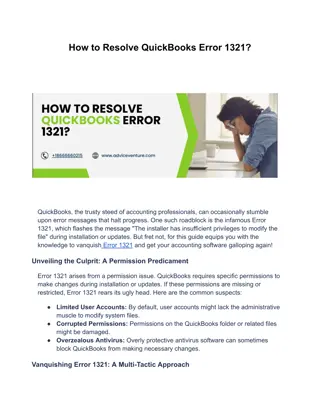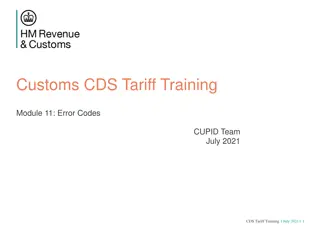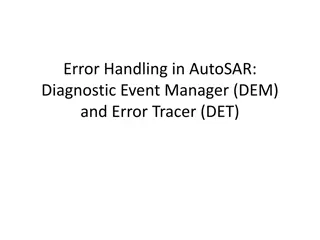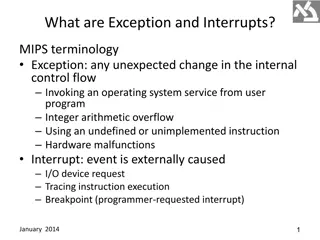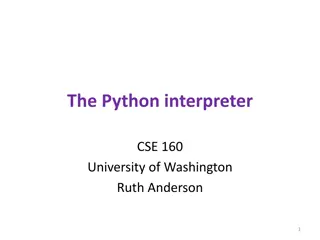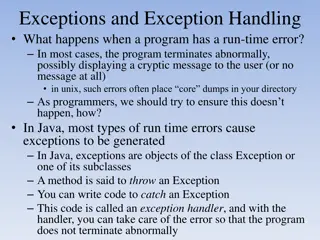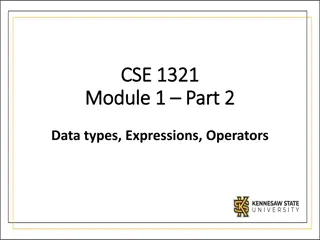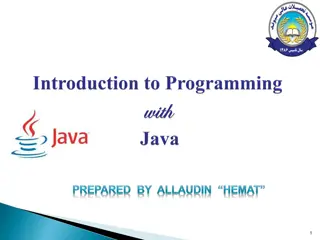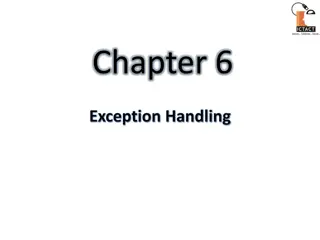Understanding Python Error Handling and Exception Types
Explore Python error handling mechanisms including try-except blocks, built-in modules, and different types of exceptions. Learn to identify and resolve syntax errors, runtime errors, and logic errors while coding in Python.
Download Presentation

Please find below an Image/Link to download the presentation.
The content on the website is provided AS IS for your information and personal use only. It may not be sold, licensed, or shared on other websites without obtaining consent from the author. Download presentation by click this link. If you encounter any issues during the download, it is possible that the publisher has removed the file from their server.
E N D
Presentation Transcript
CICS 110: Lecture 13 Slides: Kobi Falus Edited: Cole A. Reilly Today: Try-Except, Exceptions, Built-in Modules!
Learning Goals Errors/Exceptions What types are there? Try/Except How to handle errors Built-in Modules Modules that exist in python Documentation Learning from other resources
Announcements Participation 7 due Thursday Quiz 8 due Thursday Lab on Friday HW5 DUE APRIL 12th Next Wednesday
Recap Reviewing Last Week's Lecture
Comprehensions Apply an operation to every element in a collection times_2 = [x * 2 for x in range(10)] Mapping: odd = [x for x in range(10) if x % 2 == 1] Get a subset of a collection Filtering: num = 3 to_str = "Odd" if num % 2 == 1 else "Even" If..else statements in 1 line Ternary:
The Problem Investigating code that isn't working
Problem Sometimes, code doesn t work. It can print out something like this. x = 2 if x == 2: print(x) IndentationError: expected an indented block after 'if' statement on line 2
Errors While coding, things can go wrong. When this happens, we get an Error x = 2 if x == 2: print(x) When an Error is printed out automatically, what we see is an Exception. They tend to be more descriptive as well. IndentationError: expected an indented block after 'if' statement on line 2
Errors While coding, things can go wrong. When this happens, we get an Error x = 2 if x == 2: print(x) Errors can be put in 3 broad categories: Syntax Errors Runtime Errors Logic Errors IndentationError: expected an indented block after 'if' statement on line 2
Syntax Error An error in the structure of the code itself, a violation in the grammar of Python
Syntax Errors Syntax Errors Errors that are found before the code has run This is some fundamental error violating the grammar of python x = 2 if x == 2: print(x) Examples: - Missing Indentation - Missing Commas - Misspelled Words File "(FILE LOCATION)", line 3 print(x) ^ IndentationError: expected an indented block after 'if' statement on line 2
Errors Syntax Errors Errors that are found before the code has run This is some fundamental error violating the grammar of python my_list = [1 2 3] Examples: - Missing Indentation - Missing Commas - Misspelled Words File "(FILE LOCATION)", line 1 my_list = [1 2 3] ^^^ SyntaxError: invalid syntax. Perhaps you forgot a comma?
Errors Syntax Errors Errors that are found before the code has run This is some fundamental error violating the grammar of python x = [1, 2, 3] fro x in my_list: print(x) Examples: - Missing Indentation - Missing Commas - Misspelled Words File "(FILE LOCATION)", line 2 fro x in my_list: ^ SyntaxError: invalid syntax
Reading an Error Syntax Errors often tell you what line they occur near They may even give recommendations on how to fix them! File "(FILE LOCATION)", line 1 my_list = [1 2 3] ^^^ SyntaxError: invalid syntax. Perhaps you forgot a comma? my_list = [1 2 3] Note: Line numbers can be misleading. You may have to check around the line to find the error.
Runtime Error An error in performing actions undefined by python
Runtime Errors Runtime Errors Errors that are found while the code is running Runtime errors attempt illegal actions, but 'look' like valid python code. x = input('Enter a number: ') x_num = int(x) print(x_num) Examples: - Unable to Cast - Invalid Operation - Index out of Bounds Enter a number: abc File "(FILE LOCATION)", line 2, in <module> x_num = int(x) ValueError: invalid literal for int() with base 10: 'abc'
Runtime Errors Runtime Errors Errors that are found while the code is running Runtime errors attempt illegal actions, but 'look' like valid python code. x = input('Enter a number: ') y = x + 2 print(y) Examples: - Unable to Cast - Invalid Operation - Index out of Bounds Enter a number: abc File "(FILE LOCATION)", line 2, in <module> y = x + 2 TypeError: can only concatenate str (not "int") to str
Runtime Errors Runtime Errors Errors that are found while the code is running Runtime errors attempt illegal actions, but 'look' like valid python code. nums = [1, 2, 3] x = int(input('Enter a number: ')) print(nums[x]) Examples: - Unable to Cast - Invalid Operation - Index out of Bounds Enter a number: 12 File "(FILE LOCATION)", line 3, in <module> print(nums[x]) IndexError: list index out of range
Logic Error 'Functioning' Code that doesn't work as Intended/Described
Logic Errors Logic Errors -Code that runs to completion, but not as intended. Produces different output or works in a way different then intended/described. While they occur when the code is run, often only found after completion. -Don t cause the program to Stop with an Exception -Don t have associated Error Messages nums = [1,2,3] doubled = [x*3 for x in nums] # Logic Error: Should be x*2
Logic Errors Logic Errors Occur when code runs, but stop the program from running correctly without crashing. nums = [1,2,3] doubled = [x*3 for x in nums] # Logic Error: Should be x*2 Examples: - Running wrong operation - Case not accounted for - Infinite Loops (when not intended)
Logic Errors Logic Errors Occur when code runs, but stop the program from running correctly without crashing. x = int(input('Enter a number: ')) if x == 2: print('x is 2') else: print('x is greater than 2') # Logic Error: x can be less than 2 Examples: - Running wrong operation - Case not accounted for - Infinite Loops (when not intended)
Logic Errors Logic Errors Occur when code runs, but stop the program from running correctly without crashing. count = 0 while count >= 0: print(count) count += 1 # Logic Error: Infinite loop Examples: - Running wrong operation - Case not accounted for - Infinite Loops (when not intended)
Activity On the website are many blocks of code. For each one: 1. Identify if there is an error and the error category Syntax Error Runtime Error Logic Error 2. Fix the Error
Try-Except Handling Runtime Errors Gracefully
Note: Else and Finally are optional, but Try and Except aren't Try Except Try/Except catches exceptions when they occur so your code can continue running 1. Try: Code that might raise an exception 2. Except: Code that runs if an exception occurs 3. Else: Code that runs if no exception occurs 4. Finally: Code that always runs try: x = input('Enter a number: ') y = int(x) except: print('Input not number') else: print('Entered number is', y) finally: print('Done')
Note: Else and Finally are optional, but Try and Except aren't Try Except Try/Except catches exceptions when they occur so your code doesn t stop try: 1. Try: Code that might raise an exception x = input('Enter a number: ') y = int(x) except: print('Input not number') else: print('Entered number is', y) finally: print('Done') If an error occurs in this section, the code will not immediately stop
Note: Else and Finally are optional, but Try and Except aren't Try Except Try/Except catches exceptions when they occur so your code doesn t stop try: 2. Except: Code that runs if an exception occurs x = input('Enter a number: ') y = int(x) except: print('Input not number') else: print('Entered number is', y) finally: print('Done') If an error occurred in the try section, this code is run (and the exception disappears)
Note: Else and Finally are optional, but Try and Except aren't Try Except Try/Except catches exceptions when they occur so your code doesn t stop try: 3. Else: Code that runs if no exception occurs x = input('Enter a number: ') y = int(x) except: print('Input not number') else: print('Entered number is', y) finally: print('Done') This code is run only if no error occurred in the try section
Note: Else and Finally are optional, but Try and Except aren't Try Except Try/Except catches exceptions when they occur so your code doesn t stop try: 4. Finally: Code that always runs x = input('Enter a number: ') y = int(x) except: print('Input not number') else: print('Entered number is', y) finally: print('Done') This code is always run, regardless of if an error occurs in the try, except, or else blocks
Finally Weirdness def mystery(x): try: This massive link is a python tutor example of the code written here print("TRY") return 10/x except: The finally clause can add some unexpected results to your code sometimes print("EXCEPT") return False finally: print("FINALLY") return True print(mystery(0)) print(mystery(1)) https://pythontutor.com/visualize.html#code=def%20mystery%28x%29%3A%0A%20%20%20%20try%3A%0A%20%20%20%20%20%20%20%20print%28%22TRY %22%29%0A%20%20%20%20%20%20%20%20return%2010/x%0A%20%20%20%20except%3A%0A%20%20%20%20%20%20%20%20print%28%22EXCEPT%2 2%29%0A%20%20%20%20%20%20%20%20return%20False%0A%20%20%20%20finally%3A%0A%20%20%20%20%20%20%20%20print%28%22FINALLY%22 %29%0A%20%20%20%20%20%20%20%20return%20True%0Aprint%28mystery%280%29%29%0Aprint%28mystery%281%29%29&cumulative=false&curInstr=0&he apPrimitives=nevernest&mode=display&origin=opt-frontend.js&py=3&rawInputLstJSON=%5B%5D&textReferences=false
Built-in Modules Using the web to expedite the programming process
What is a module Built-in modules are modules already added to python A Module is a collection of code you can use They have code written by other people import math x = int(input('Enter a number: ')) print(f'Log is {math.log(x)}') print(f'Square root is {math.sqrt(x)}') print(f'Pi is {math.pi}')
What is a module Built-in modules are modules already added to python A Module is a collection of code you can use You ve already done this with math! import math We can also do this with the code we've written in class x = int(input('Enter a number: ')) print(f'Log is {math.log(x)}') print(f'Square root is {math.sqrt(x)}') print(f'Pi is {math.pi}')
PPrint It allows you to print dictionaries (and other types) nicely Pprint (Pretty Print) is a module built-in to python Try it out! Modify the dict and see how the output changes! import pprint my_dict = {'name': 'John', 'favorite_numbers': [1, 2, 3], 'favorite_colors': ['red', 'blue', 'green']} print(my_dict) pprint.pprint(my_dict)
A Selection from the Standard Library Module name Description Documentation link datetime Creation and editing of dates and times objects https://docs.python.org/3/library/datetime.html random Functions for working with random numbers https://docs.python.org/3/library/random.html copy Create complete copies of objects https://docs.python.org/3/library/copy.html time Get the current time, convert time zones, sleep for a number of seconds https://docs.python.org/3/library/time.html math Mathematical functions https://docs.python.org/3/library/math.html os Operating system informational and management helpers https://docs.python.org/3/library/os.html sys System specific environment or configuration helpers https://docs.python.org/3/library/sys.html pdb The Python interactive debugger https://docs.python.org/3/library/pdb.html urllib URL handling functions, such as requesting web pages https://docs.python.org/3/library/urllib.html
Documentation/Datetime Using the web to expedite the programming process
Documentation Information about modules (and python in general) is stored online. This information is called documentation Some trustworthy sources are: -w3schools.com -geeksforgeeks.org -tutorialspoint.com -stackoverflow.com Let s use these to learn how to use a module!
Datetime Datetime is a built-in module that lets you do math with dates It can let you: -Get the current date -Find How many days it has been since January 1st -Print out how many days have passed Let s use the following documentation to learn about module w3schools.com/python/python_datetime.asp
Datetime Sometimes a single resource doesn t have all the information you would need Let s try to find out what day it was 61 days ago! Try Searching: python datetime days ago
Activity Use datetime and documentation to: 1. Get the current date 2. Find out the day of the week 61 weeks ago 3. Print out the day of the week! If you are stuck, try looking up how to do it! Googling format: Python {my_problem}
Recap + Closing Let s review
What did we learn? Errors Syntax, Runtime, Logic Using Exceptions Using Documentation to further our understanding Try-Except Stopping your code from crashing Documentation Using code not originally written in the file Built-in Modules Modules
Announcements Participation 7 due Thursday Quiz 8 due Thursday Lab on Friday HW5 DUE APRIL 12th Next Wednesday




